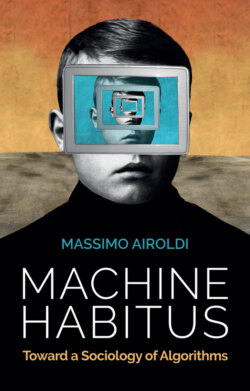Читать книгу Machine Habitus - Massimo Airoldi - Страница 2
ОглавлениеTable of Contents
1 Cover
2 Title Page
3 Copyright Page
4 Quote
5 Acknowledgments
6 Figures and Tables Figures Tables
7 Preface
8 1 Why Not a Sociology of Algorithms? Machines as sociological objects Algorithms and their applications, from Euclid to AlphaGo Analogue Era (–1945) Digital Era (1946–1998) Platform Era (1998–) Critical algorithm studies Open questions and feedback loops Seeing algorithms with the eyes of Pierre Bourdieu Notes
9 2 Culture in the Code Born and raised in Torpignattara Humans behind machines Machine creators Machine trainers Society in, society out Data contexts Traces and patterns Global and local Machine socialization Practical reason and machine habitus Primary and secondary machine socialization Notes
10 3 Code in the Culture The haircut appointment Algorithms: agency and authority Machine agency Computational authority Algorithmic distinctions How socialized machines interact More-than-human relations Informational asymmetry and cultural alignment A typology of user–machine interactions Platforms as techno-social fields Encapsulating and confounding Reinforcing, or transforming?
11 4 A Theory of Machine Habitus Premises Structures Social structure Digital infrastructure Entanglements Trajectories Temporality Multiplicity Boundaries Social, symbolic and automated Four scenarios of techno-social reproduction
12 5 Techno-Social Reproduction Toward a sociology of algorithms as social agents An old but new research agenda Beyond a sociology of algorithms
13 Bibliography
14 Index
15 End User License Agreement
List of Illustrations
1 Chapter 1Figure 1 Algorithms: a conceptual map, from Euclid to AlphaGo
2 Chapter 2Figure 2 Networks of associated words learned by IAQOS. Source: IAQOS 2019.Figure 3 An example of a phishing email targeting my professional email address, not auto...
3 Chapter 3Figure 4 On the left-hand side, related music videos network (directed); on the right-han...
4 Chapter 4Figure 5 Techno-social effects on field boundaries
List of Tables
1 Chapter 2Table 1 Machine socialization processes in different types of algorithms
2 Chapter 3Table 2 Types of user–machine interaction (effects on users in brackets)
3 Chapter 5Table 3 Research directions for the sociology of algorithms, with selected example studi...
Guide
1 Cover
2 Table of Contents
3 Begin Reading
Pages
1 iii
2 iv
3 vi
4 vii
5 viii
6 ix
7 x
8 xi
9 xii
10 1
11 2
12 3
13 4
14 5
15 6
16 7
17 8
18 9
19 10
20 11
21 12
22 13
23 14
24 15
25 16
26 17
27 18
28 19
29 20
30 21
31 22
32 23
33 24
34 25
35 26
36 27
37 28
38 29
39 30
40 31
41 32
42 33
43 34
44 35
45 36
46 37
47 38
48 39
49 40
50 41
51 42
52 43
53 44
54 45
55 46
56 47
57 48
58 49
59 50
60 51
61 52
62 53
63 54
64 55
65 56
66 57
67 58
68 59
69 60
70 61
71 62
72 63
73 64
74 65
75 66
76 67
77 68
78 69
79 70
80 71
81 72
82 73
83 74
84 75
85 76
86 77
87 78
88 79
89 80
90 81
91 82
92 83
93 84
94 85
95 86
96 87
97 88
98 89
99 90
100 91
101 92
102 93
103 94
104 95
105 96
106 97
107 98
108 99
109 100
110 101
111 102
112 103
113 104
114 105
115 106
116 107
117 108
118 109
119 110
120 111
121 112
122 113
123 114
124 115
125 116
126 117
127 118
128 119
129 120
130 121
131 122
132 123
133 124
134 125
135 126
136 127
137 128
138 129
139 130
140 131
141 132
142 133
143 134
144 135
145 136
146 137
147 138
148 139
149 140
150 141
151 142
152 143
153 144
154 145
155 146
156 147
157 148
158 149
159 150
160 151
161 152
162 153
163 154
164 155
165 156
166 157
167 158
168 159
169 160
170 161
171 162
172 163
173 164
174 165
175 166
176 167
177 168
178 169
179 170
180 171
181 172
182 173
183 174
184 175
185 176
186 177
187 178
188 179
189 180
190 181
191 182
192 183
193 184
194 185
195 186
196 187
197 188
198 189
199 190
200 191
201 192
202 193
